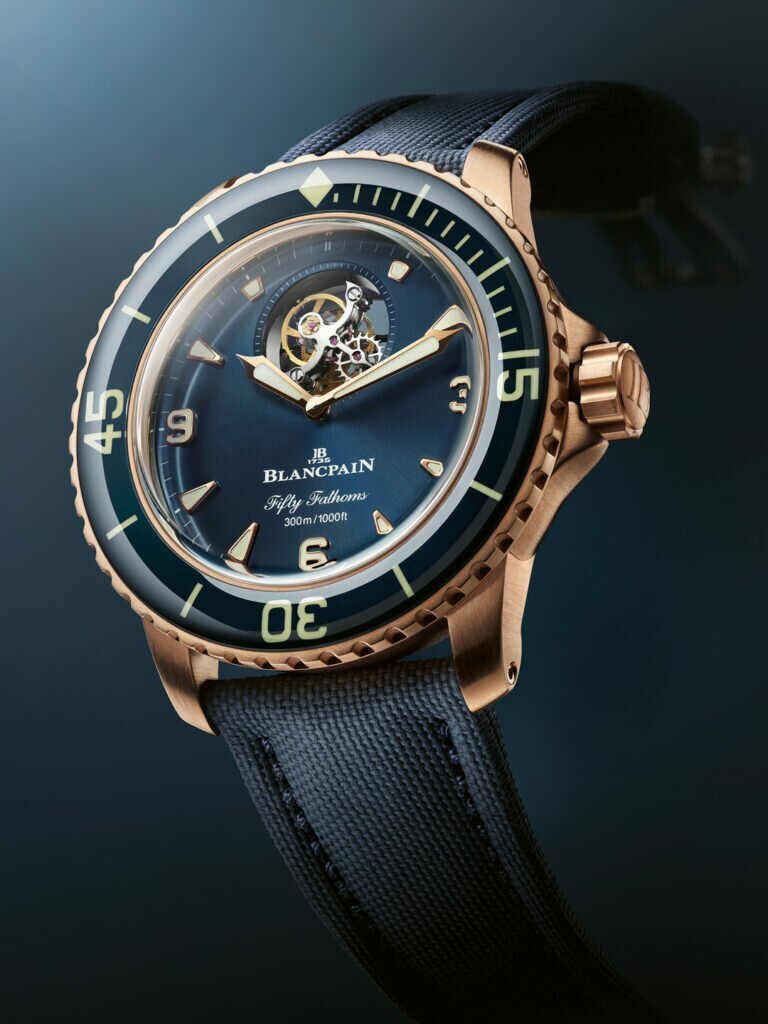With a history dating back to 1953 and an origin story that involves secret agents and the forming of an elite unit of combat divers, Blancpain’s Fifty Fathoms dive watch has no lack of inspiration for new references. So much so that it doesn’t even need to pay homage to 60-year-old watches to capture the attention of the currently vintage-obsessed masses. The collection has two new additions, and they are utterly future-facing in style and function.
First, we have the Fifty Fathoms Tourbillon 8 Jours Ref. 5025. The watch debuted in 2007 as part of a collection that would show off Blancpain’s complication know-how. Because why would anyone need a tourbillon — and a flying one, no less — in a watch built for underwater adventures? No reason other than to show off the technical skill required to do so. That something as refined as a tourbillon can look right at home in a dive watch is also testament to the Fifty Fathoms’ versatile and timeless design.
Speaking of its design, some key elements remain the same in the Ref. 5025. These include the dimensions (45mm by 14.8mm), 60-minute uni-directional bezel, diamond index at noon, 15-minute scale and Arabic numerals at 3, 6 and 9 o’clock.
-

Fifty Fathoms Tourbillon 8 Jours Ref. 5025 in titanium. -

Fifty Fathoms Tourbillon 8 Jours Ref. 5025 in titanium.
What’s new are two new case materials — grade 23 titanium and red gold — and a fresh blue face. While grade 2 and grade 5 titanium are most commonly used in watchmaking cases, Blancpain has opted for the purer grade 23 variation. Its higher strength and toughness, as well as light weight and excellent corrosion resistance makes it the preferred grade for use in biomedical applications. Both the red gold and titanium cases are satin-finished, and built with a water resistance of 30 bar.
Another notable difference in the Ref. 5025 is the removal of the power reserve indicator, previously found at 6 o’clock. Cleaning up the dial this way lets the focus fall squarely on the beautiful tourbillon. The self-winding Calibre 25C provides eight days of reserve power and is finished with Côtes de Genève and circular graining. Both editions come with a blue Nato sailcloth strap, but the titanium model comes with an additional titanium bracelet.
Since the core Fifty Fathoms collection houses models that range from heavy duty instruments to dressier ones like the Ref. 5025, those looking for a more casual, daily wear dive option can look to the Fifty Fathoms Bathyscaphe. Also a product of the 1950s, the Bathyscaphe too was revived in recent years to become the smaller, lighter alternative to its military big brother.
In the past decade, the Bathyscaphe has enjoyed many iterations in various materials, such as stainless steel, ceramic and gold, and with a diverse array of complications including calendars, chronographs and moonphases. But joining the current collection is its first titanium-cased Bathyscaphe with a simple time and date configuration.
-

Fifth Fathoms Bathyscaphe with a full titanium three-link bracelet. -

Fifth Fathoms Bathyscaphe
Titanium and ceramic-coated titanium Bathyscaphes have existed in the past, but this Bathyscaphe Titanium 43mm is arguably the most sophisticated of the lot. The case and bracelet, both made of grade 23 titanium, have been satin-brushed to match the vertical satin finish of the anthracite-coloured dial. The bezel, also titanium, is filled with ceramic using Blancpain’s Liquidmetal technology to ensure flawless integration, but keeps a matt look to complement the rest of the watch. Truly, a watch that delivers austerity with panache.
The in-house Calibre 1315 is self-winding and offers a comfortable five-day power reserve. It is also equipped with a silicon balance spring, which means it requires no lubrication and is impervious to magnetic influence. Sensibly, movement decoration has also been kept to a minimum to match the no-nonsense aesthetic, offering just snailed and chamfered bridges, and a sandblasted, satin-finished and snailed gold rotor.
There are three strap options for the Bathyscaphe Titanium 43mm. One is a grey Nato strap, another is an anthracite-coloured sailcloth strap and lastly, there is a full titanium three-link bracelet, which is identical to the ones used in the Fifty Fathoms collection — the first time for a Bathyscaphe.
